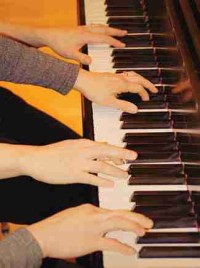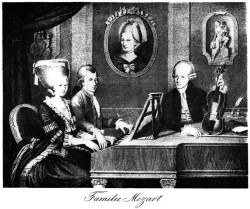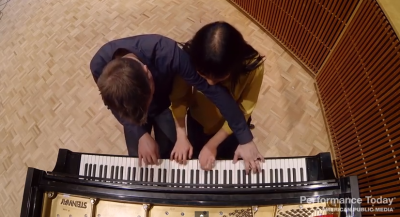 A former student from France recently spent a weekend with us while she was in the States on vacation. We had a lot of years to catch up on, enjoyed good food and wine, and found some time to play four-hand music. Four-hand music is fun to play, but it can be notoriously awkward because not only are two pianists sharing the same piano, they are often sharing the same segment of the keyboard. It occurred to me that, in spite of the awkwardness, the sharing of space has worked well with everyone with whom I’ve ever played – with one glaring exception.
A former student from France recently spent a weekend with us while she was in the States on vacation. We had a lot of years to catch up on, enjoyed good food and wine, and found some time to play four-hand music. Four-hand music is fun to play, but it can be notoriously awkward because not only are two pianists sharing the same piano, they are often sharing the same segment of the keyboard. It occurred to me that, in spite of the awkwardness, the sharing of space has worked well with everyone with whom I’ve ever played – with one glaring exception.
The exception was an elderly musicologist I used to know who was familiar with the entire four-hand repertoire, but who really thought that he had the keyboard to himself. The one time that I played with him, my fingers were bloody after he had stabbed me several times when the music required us to play in particularly close proximity.
But most of us, when playing four-hand music (sometimes called piano duets), manage to accommodate each other remarkably well. And recent research from the Karolinska Institute in Sweden sheds some light on why this is the case. And it all has to do with something called peripersonal space.
We all have a bubble of space around our bodies that is mapped in our brain, and it extends about the length of your arm. If you stand and hold your arms out in front of you, then raise them overhead, move them in every direction and then move your legs as far as they can reach as well, all of the space your limbs have just gone through is your peripersonal space.
Our brains map everything that happens within that space. If you are using a fork, a rake, a drum stick or mallet, a violin or cello bow, or driving your car, your peripersonal space extends to the end of the tool you are using, to the end of your bow, or to the outside perimeter of the car. You can feel the texture of the plate or the food through the fork because your brain is mapping the fork as an extension of your arm. And you can usually park your car without hitting the car in front of or behind you, because your brain is mapping the body of the car as an extension of you.
I live in Amish and Mennonite country. A few years ago, a runaway horse and buggy headed straight for my car as I stopped to check the traffic before entering a busy highway. In the brief moments that my brain registered what was happening, my cognitive brain told me that I was safe because I was inside the car, but the part of the brain mapping my peripersonal space reacted very strongly because the car was about to be hit and my brain mapped the car as an extension of me. I instinctively moved as far away from the oncoming horse as I could – within the confines of the front seat.
The horse, in fact, veered just before hitting the car, but the buggy hit the right front fender. I was fine, the buggy was smashed, and my car needed some body work. (The horse was fine as well – he just kept running.)
There is a reason that our brains map the space around us, and that’s because in order to help us move through space, the brain has to monitor our position and movement in relationship to objects or people around us. If I’m hiking and about to walk into a low-hanging branch, my brain maps it so I can move out of the way. If I’m dancing, my brain is mapping the space around me so that I don’t run into other dancers. If you are playing soccer, your brain is mapping the space around you and the players within that space.
So what does peripersonal space have to do with playing four-hand music? When you play four-hand music, the two pianists are in each other’s peripersonal space all the time. If I’m playing Primo, or the top part, the pianist to my left playing Secondo is in my peripersonal space. And I am in hers.
One could say that through practice, you learn to accommodate and stay out of each other’s way and that’s true, but there is a reason that we are able to do that. Recently at the Karolinska Institute, researchers showed that there are neurons in our brain that “mirror” the space of others near us – just as if it were the space around ourselves.
The researchers found a class of neurons in the brain that maps the space not only around my own hand (my peripersonal space), but also the peripersonal space around someone in close proximity to me – in other words, my piano partner. So my peripersonal space actually encompasses the peripersonal space of my partner, and hers encompasses mine.
We each are mapping in our own brains – not only everything that we are doing – but everything that our piano partner is doing as well, and that’s actually what allows us to play together at the keyboard without constant flinching or moving out of the way because our space is being invaded.
Is it necessary to know about the brain and peripersonal space in order to play four-hand or  eight-hand music? Obviously not, since four-hand repertoire goes back to the 18th century – long before anyone knew about peripersonal space. Notice Mozart and his sister Nannerl playing four-hand music – and look at the position of their hands.
eight-hand music? Obviously not, since four-hand repertoire goes back to the 18th century – long before anyone knew about peripersonal space. Notice Mozart and his sister Nannerl playing four-hand music – and look at the position of their hands.
But I think this is fascinating research, because it explains yet another “shortcut” that the brain allows us to make. In earlier posts, we talked about mirror neurons and how certain neurons in our brain mirror the actions of others, thereby providing a shortcut for us to understanding those actions.
Now we find that the brain also mirrors and maps the space around people in close proximity to us. Think about it. If we literally had to choreograph the positions of our hands and bodies throughout an entire piece of four-hand music in order to play it, it would be extremely tedious and we probably wouldn’t bother. But the brain does much of it for us at an unconscious level – a kind of shortcut.

On the other hand, Anderson & Roe’s delightful arrangement of Papageno is clearly choreographed. I assume their particular arrangement was meant to showcase their four-hand virtuosity, and it certainly does. They weave in and out of each other’s space effortlessly. And when I watch them, the idea that each of their brains is mapping all the space around both of them makes perfect sense.